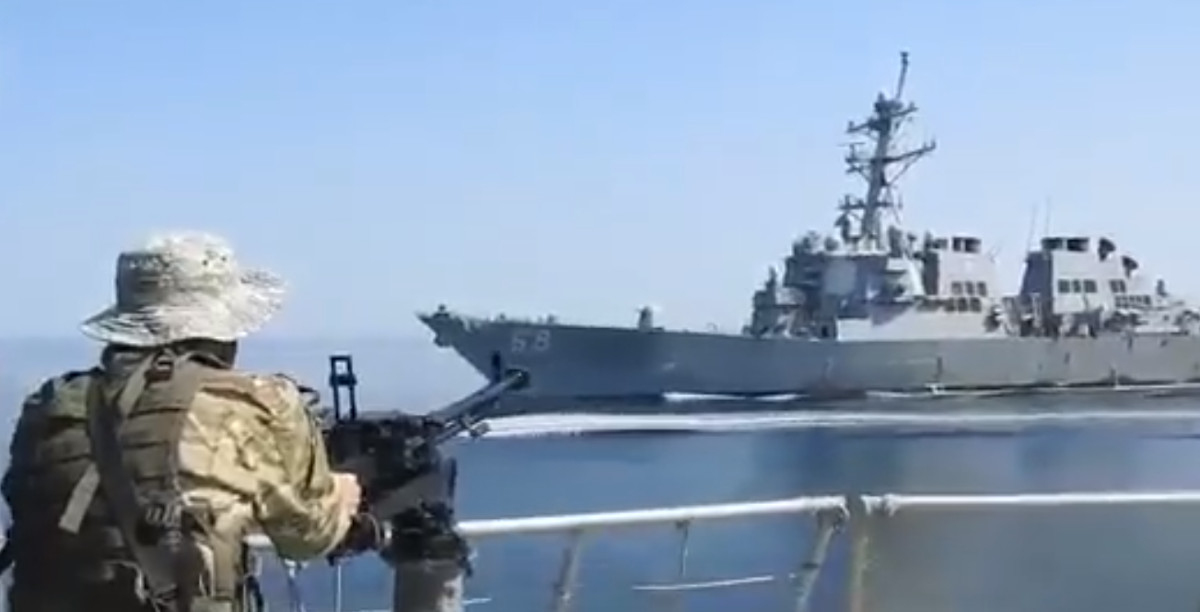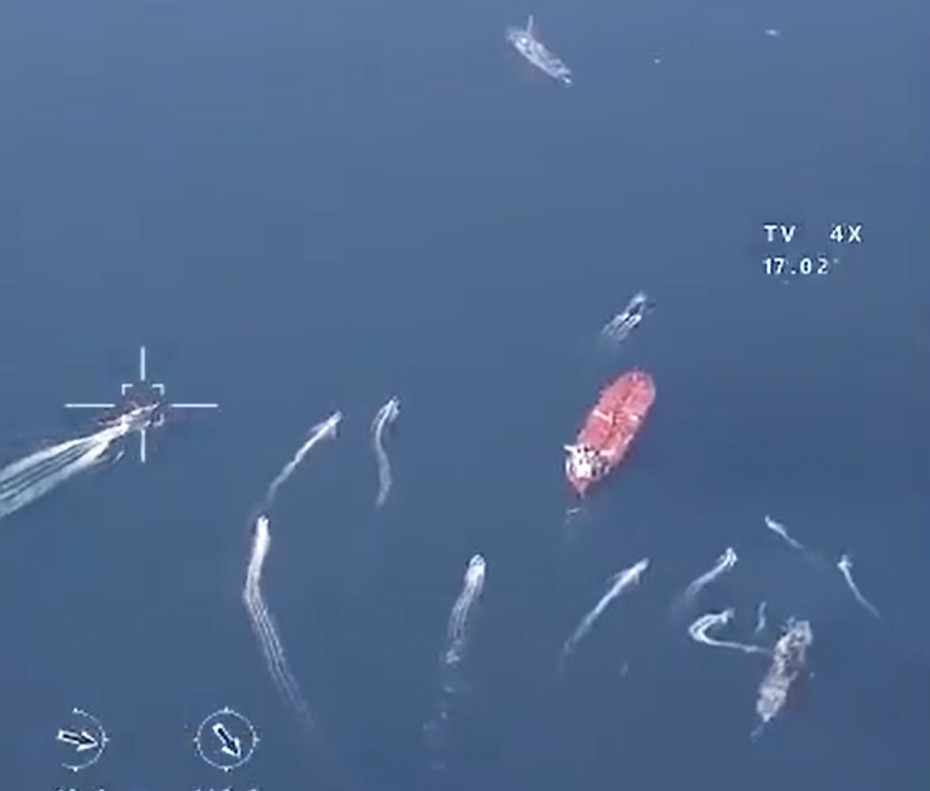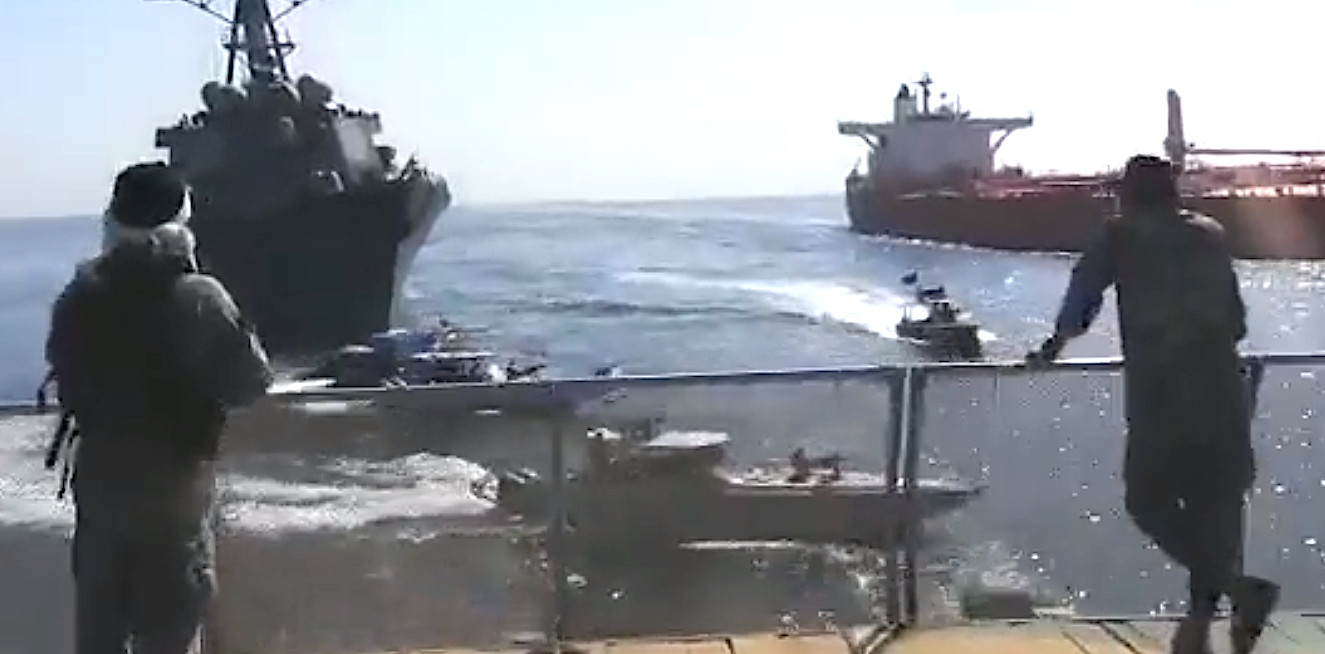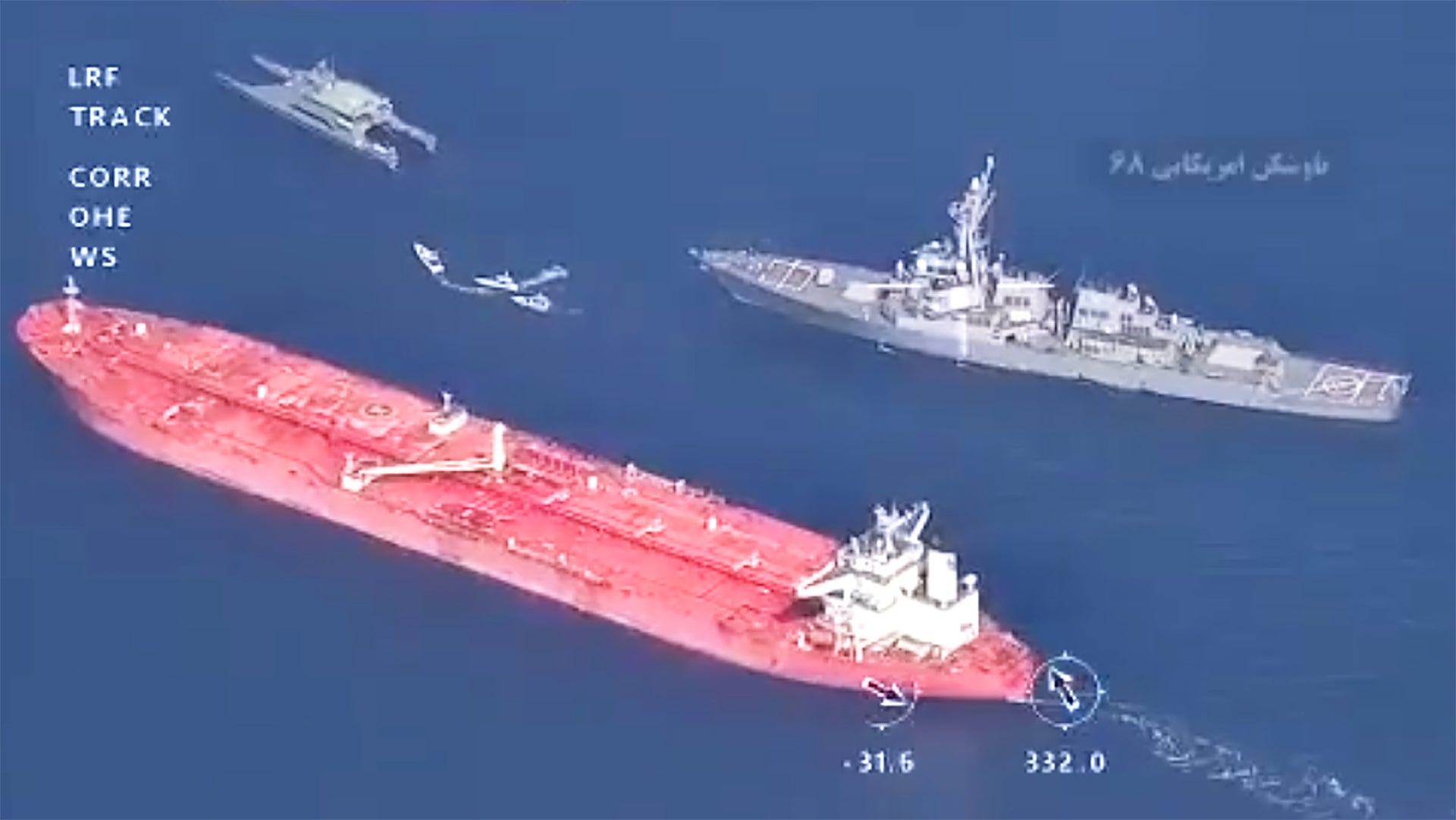Iran has released dramatic video footage of an incident in the Gulf of Oman, which reportedly took place last week. Iran’s Islamic Revolutionary Guard Corps seized the Vietnam-flagged tanker ship Sothys and then appears to have sent small boats to swarm two U.S. Navy Arleigh Burke class destroyers, as well as U.S. Coast Guard cutters, in what by every indication is an unprecedented altercation.
From what we can see in the footage, members of the Islamic Revolutionary Guard Corps (IRGC) swarmed the Sothys using small boats, including the unusual catamaran vessel Shahid Nazeri, and also landed a boarding party on the tanker’s deck using a Bell 412 helicopter. The IRGC has used similar tactics when seizing other commercial tankers in the past.
Other clips indicate that the Arleigh Burke class destroyers USS The Sullivans (DDG-68) and USS Michael P. Murphy (DDG-112), which are both known to be operating in the region, arrived on the scene. At least one U.S. Coast Guard Sentinel class Fast Response Cutter is also seen in the footage. The Coast Guard sent two of these vessels, the USCGC Charles Moulthrope and USCGC Robert Goldman, to the Middle East earlier this year.
At least one MH-60R Seahawk helicopter is seen in the footage, which would have been launched from either The Sullivans or Michael P. Murphy. The helicopter appears to be carrying two AGM-114 Hellfire missiles.
What is then seen in the video clips are a series of very close interactions between at least The Sullivans, which came up alongside the Sothys, and Iranian boats. IRGC personnel are seen pointing deck-mounted machine guns at the American ship, though there is no indication any shots were fired. There are various overhead views of the entire event, which would have been filmed by Iranian manned aircraft or drones, showing the numerous ships and small boats all in very close proximity around the tanker.


While we don’t know exactly how close U.S. and Iranian vessels came to each other, it is clear that some of the distances involved were extremely short. At one point in the footage, as seen below, IRGC boats cut right in front of the bow of The Sullivans. These kinds of interactions can be highly dangerous for all parties involved because of the risks of collisions. Larger ships, such as an Arleigh Burke class destroyer —which is more than 500 feet in length and displaces more than 8,000 tons — may not even necessarily see a smaller vessel and could have trouble stopping or otherwise maneuvering out of the way in these kinds of situations.

A collision in a scenario like this could then prompt further escalation. There were a number of instances earlier this year in the Persian Gulf where U.S. naval forces actually fired warning shots at IRGC vessels that were operating in unsafe and unprofessional ways nearby. The Sullivans would also have been very vulnerable in this situation to other kinds of attacks. For instance, if one of these small boats had been laden with explosives, it could have done significant damage to the ship.
The details about exactly what prompted this particular episode are still murky. Iranian state media outlets first disclosed the incident earlier today but provided only limited details about what had happened. A subsequent report from Newsweek, citing a U.S. official, said that the Islamic Revolutionary Guard Corps’ seizure of the Sothys occurred last week, but it remains unclear exactly when these events took place. Satellite imagery indicates that Sothys is now anchored near Iran’s Qeshm Island in the Strait of Hormuz, which links the Gulf of Oman to the Persian Gulf.
A U.S. Air Force RC-135W Rivet Joint and a U.S. Navy EP-3E Aries II, both of which are intelligence, surveillance, and reconnaissance (ISR) platforms, were spotted flying today over the Gulf of Oman in the general vicinity of where the incident is likely to have occurred. However, American ISR flights in the region are commonplace, and it is unclear whether this activity is directly linked to this recent tanker seizure.
Iran claims that the IRGC’s actions were prompted by attempts by the U.S. government to “steal” Iranian oil onboard the ship and that they blocked an attempt to recapture the Sothys. Iranian authorities further asserted that American forces had previously detained a different tanker carrying Iranian oil and then transferred it at sea to the Sothys.
The United States has publicly announced the seizure of vessels carrying Iranian oil in violation of American sanctions before. There is satellite imagery that shows Sothys alongside the Oman Pride, a sanctioned tanker, off Oman in June, which could point to a ship-to-ship transfer, as well.
However, “we’re refuting the Iranian claims that they prevented us from taking back this vessel,” the unnamed American official told Newsweek. “Here’s the bottom line. This occurred last week. U.S. naval forces in the Gulf of Oman observed Iranian naval forces seize this oil tanker.”
When reached for comment, the U.S. Navy’s Office of the Chief of Information redirected The War Zone to U.S. Central Command. CENTCOM subsequently said it had no statement to offer about the reported incident at present. U.S. Naval Forces Central Command (NAVCENT) similarly declined to comment, but said it was aware of the various media reports, according to The Guardian in the United Kingdom.
There are separate unconfirmed reports that the Wasp class amphibious assault ship USS Essex was harassed by Iranian drones during a transit of the Strait of Hormuz in the past day or so. The War Zone has reached out to NAVCENT for more information about that reported incident.
It is important to note that the veracity of the video clips, seen below via Iran’s semi-official Fars News, now circulating online cannot be readily verified independently. There is the possibility that portions of the footage may not necessarily all be from this recent reported incident or may have been otherwise altered in some way.
If the footage the Iranians released is an accurate depiction of the reported events last week, even in part, it certainly reflects yet another serious high-seas encounter between the two countries. It certainly underscores the risks inherent in the U.S. government’s efforts to enforce crippling sanctions on the regime in Tehran. Sanctions relief continues to be a major sticking point in indirect negotiations between Washington and Tehran regarding the U.S. government’s potential return to a controversial multinational deal over Iran’s nuclear ambitions.
In the meantime, now that Iran has released all of this video footage to support its version of events, it seems likely that the U.S. government will at have to respond more directly to those claims.
We will continue to update this story as more information becomes available.
Updated 10:25 PM EST:
Pentagon Press Secretary John Kirby responded to questions regarding this incident, which he said took place on Oct. 24, at a press conference earlier today. Kirby insisted that American forces on the scene were simply monitoring the situation, rather than attempting to intervene, and refuted Iran’s claim that the oil Sothys was carrying had been seized earlier by the United States. He declined to confirm the identity of the tanker at the center of the incident himself or explain why the U.S. military had not previously disclosed that this altercation had occurred.
The full exchange between him and members of the Pentagon press pool on this matter is as follows:
Q: Hello John, the Iranians have said that U.S. tried to seize some Iranian oil. And they prevented it and I wanted to have your side of the story to explain me what happens?
MR. KIRBY: I’ve seen the Iranian claims they are absolutely totally false and untrue. There was no such effort by U.S. naval assets to seize anything. What this refers to is back on the 24th of October, U.S. Navy assets did monitor Iranian forces, illegally boarding and seizing a merchant vessel in international waters in the Gulf of Oman.
United States Fifth Fleet directed two ships and aerial assets to closely monitor that situation at no time were U.S. forces attempting to retake or otherwise engage in the situation’s — we acted completely in accordance with the law. So, it’s a bogus claim.
Q: OK. They said that, actually, there were two tankers, that the U.S. seized the oil from the first tanker and put it in second tanker. You don’t confirm that?
MR. KIRBY: I not only don’t confirm it. It’s a ridiculous claim. It’s absolutely not true. And I would add that Iran’s actions, the ones that are true of them, illegally boarding and seizing a merchant vessel constitute a blatant violation of international law. That undermines freedom of navigation in the free flow of commerce.
Q: Do you know, that…
MR. KIRBY: The only seizing that was done was by Iran.
Q: Do you know the nationality of the tanker they seized?
MR. KIRBY: I do, but I’m not at liberty to say that. I think we would refer to that individual nation to speak to that.
Q: On this topic.
MR. KIRBY: Yes.
Q: So, based on the video from the Iranian side, and what you just stated. There were U.S. Navy assets and airplanes?
MR. KIRBY: And I said that, they were monitoring.
Q: My question is about the monitoring part. I mean, you have NAVCENT, and you have the IMSCC. Combined together their mission is basically to maritime — to ensure maritime stability security of the sea lines of communication, deter state sponsored malign activity, reassure the merchant shipping in that region. I mean, evidently the U.S. didn’t do any of that. I mean, where’s the assurance? And where’s the deterrent effect of your presence?
MR. KIRBY: What I can tell you is we acted in accordance with international law, unlike the Iranians, and I’ll leave it at that.
Q: There was an intentional effort not to escalate the situation?
MR. KIRBY: We acted in accordance with international law, unlike the Iranians. And we do believe our forward presence in that part of the world has and will continue to act as a deterrent. Does it deter every action by the Iranians and the particularly the IRGC maybe? No, that’s one of the reasons why we’re there to help as I said, support freedom of navigation and free commerce.
That’s one of the reasons why we have a naval presence there. As well as many of our allies and partners. But we acted in accordance with international law. And I think your question would also be well put to the folks in Tehran.
Q: Our correspondent is in Tehran, my follow up on this is what did the (unintelligible) wait until today, to come out with its version of what happened?
MR. KIRBY: There was no waiting Fahdi. We were monitoring, we monitor a lot of activity in that part of the world. It’s not about waiting. We are reacting to false claims that the Iranians made today. So, if you’re asking me, why am I talking about this today, because you’re asking me about it today. Because the Iranians lied about it today. But we monitor maritime traffic every day out there, and not all of it rises to the level of us putting out a press release or talking about it overtly from the podium. Patty.
Q: If you looked at the video, those small ships, small boats were really close to that destroyer. As you know, and we know, after the Cole, that was a huge concern. Did the captain, that the crew do anything to try and sort of swat away the small boats. Were they allowed to do anything? Or were you — just to order to avoid escalation?
MR. KIRBY: I don’t know. I mean, I wasn’t there, Patty. So, I’m not going to speak for the commanding officer of the destroyer. And what force protection measures they might have taken. What I can tell you is that the commanding officers of our ships always have the right to self-defense. And multiple ways to defend their ship, and their crew. And they know they had those authorities. They know, they had those capabilities. Now, what actually transpired aboard that particular destroyer, I wouldn’t get into. I’d refer you to the Navy or to the central command to talk about that in more detail. Yes.
Q: Was there any possibility that the ship was engaged in piracy of any sort or illicit oil transfers or anything like that?
MR. KIRBY: I don’t have any additional information about the ship that the Iranians illegally boarded and seized? And again, I just don’t have more.
Q: Why were we tracking?
MR. KIRBY: Why were we tracking?
Q: Yes, why were we tracking?
MR. KIRBY: We monitor a lot of traffic in that part of the world? Yes, Abraham.
Contact the author: joe@thedrive.com
